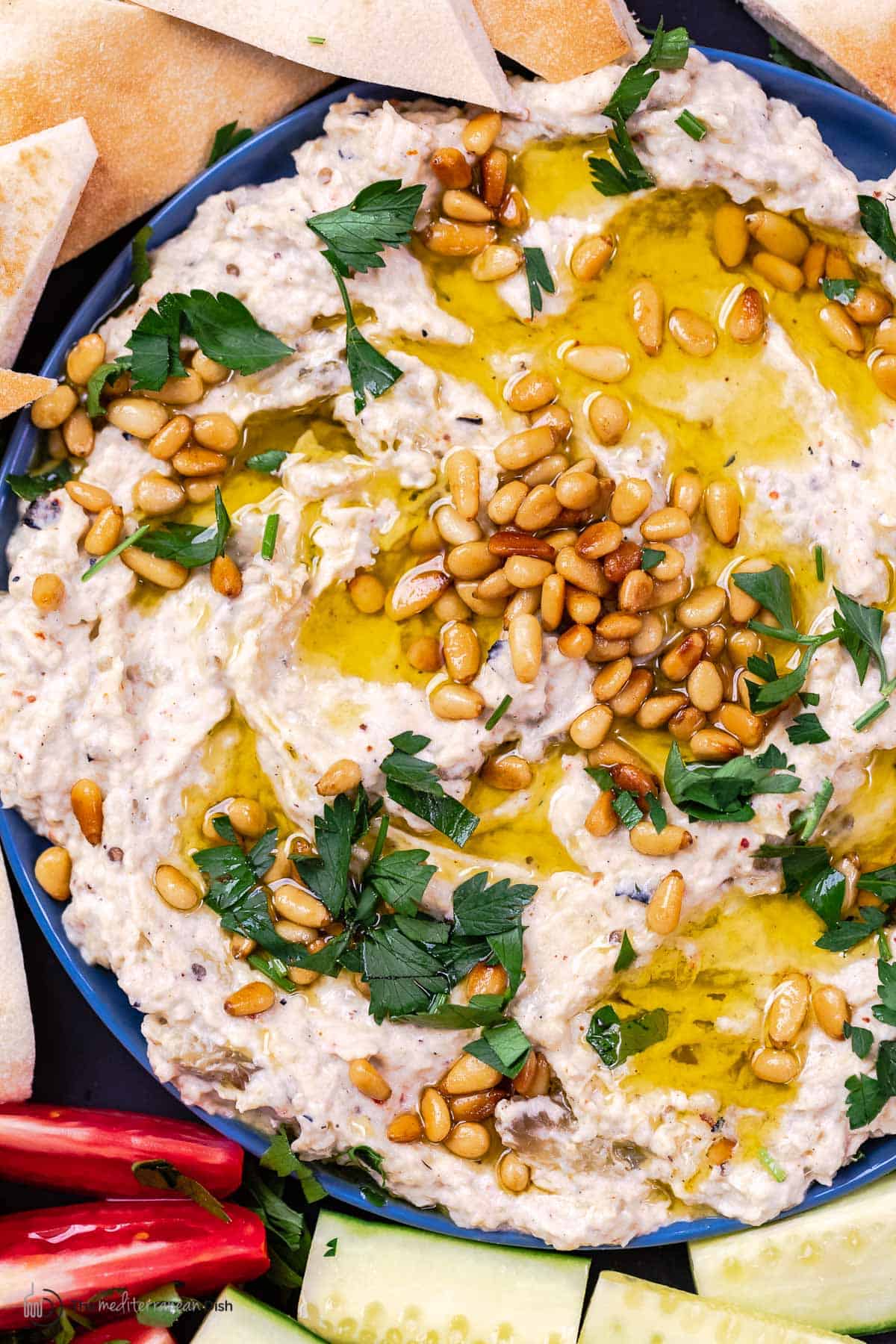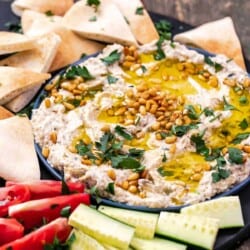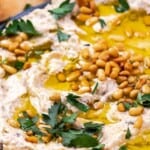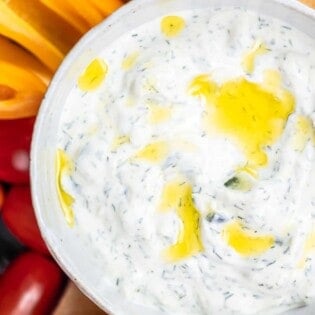Creamy, savory, smoky eggplant dip with tahini, garlic and citrus, this authentic baba ganoush recipe is a must-try! Expert tips + video.

People of the Mediterranean sure love their dips! From Greek tztaziki to hummus, muhammara, and, of course, baba ganoush! I mean, what better way to kick-start your dinner than a creamy, dreamy dip and some homemade pita to go with it?!
I’m excited to share with you my family’s baba ganoush recipe (smoky eggplant dip), complete with a few secrets that make all the difference!
What is Baba Ganoush?
Baba ganoush–also known as baba ganouj, muttabal, or salat hatzilim–is a smoky, rich, and creamy eggplant dip, traditionally made by mixing tender roasted (or charred) eggplant and nutty tahini with garlic, citrus, and spices.
The literal meaning of baba ganoush or baba ganouj is “spoiled dad,” referring to the fact that when you eat it, you just can’t help but feel a bit spoiled! There is a reason the French call it caviar d’aubergines, it is that delectable!
Luckily, this eggplant dip is easy to make at home, and I’m excited to share with you my family’s recipe complete with tips for how to make baba ganoush perfectly every time!
Baba ganoush ingredients
Let’s walk through the simple ingredients you need to make it:
- Eggplant. I use 2 smaller eggplant. Italian eggplant or the smallest glove eggplant you can find work best, they will have less seeds and the flesh is tender and not bitter.
- Tahini paste. Tahini paste is made of toasted sesame seeds. I use Soom tahini made of 100% roasted and pressed organic Ethiopian White Humera sesame seeds offering a creamy texture and a nutty flavor.
- Garlic. 1 to 2 fresh garlic cloves, depending on how garlicy you enjoy your dips.
- Lemon juice. Citrus gives this eggplant dip a nice lift. You can make it as subtle or lemony as you like.
- Greek Yogurt (secret optional ingredient) If you’re going for a vegan baba ganoush, omit the yogurt, but otherwise it is a great way to thicken the dip, making it even more creamy, while also enhancing the color turning it from a deep beige to something a little brighter and more appealing.
- Seasonings. Salt and pepper, of course. If you like, add a bit of Sumac and cayenne pepper for heat.
- Extra virgin olive oil. A drizzle of a rich and peppery extra virgin olive oil over this dip is the perfect way to finish it!
- Garnish. If you like, add toasted pine nuts and some chopped fresh parsley to serve.

How to make baba ganoush
Baba ganoush is easier to make than you think, you’ll start by cooking the eggplant (either by grilling over open flame or baking it in the oven), and then mixing it with the remaining ingredients to make a delicious dip! Here is how:
- Grill or bake the eggplant. Grill the eggplant whole over an open flame over medium-high heat (I used my gas burner, but you can cook it on the grill), turning occasionally, with a pair of tongs, until the eggplant has fully charred on the outside and the flesh has collapsed and softened (about 15 to 20 minutes).
Alternatively, you can roast the eggplant in a high-heated oven. Int his case, cut the eggplant in have and place it flesh side down on a large lightly-oiled baking sheet and roast at 425 F for about 40 minutes or until the eggplant is very soft and cooked through. - Cool and Drain Well. Put the cooked eggplant in a colander and, using a knife, open it up a big so that it will cool quickly and drain its juices. Push down on the eggplant with the back of the spoon so that any excess water will drain well.

- Peel off the skin. When cool enough to handle, peel the charred skin off the eggplant and the stem and discard (Note: if you baked the eggplant instead, you may simply need to scoop out the flesh with a spoon.
- Gently mix the eggplant with the tahini and remaining ingredients. At this point, make sure your eggplant is fully cooled and is rid of excess water, then transfer it to a large bowl. Add in the tahini (a good 1/4 cup for rich and nutty flavor), minced garlic, fresh lemon juice, and, the optional secret ingredient, about 1 tablespoon of Greek yogurt. Season with a good pinch of kosher salt, and if you like, a little sumac and Aleppo pepper or red pepper flakes, if you like heat. Using a wooden spoon, mix gently to combine.
- Chill. If you have the time, cover the baba gnoush and chill it in the fridge for a few minutes or sit it aside while you work on something else
- Serve. Spread the baba ganoush on a serving rimmed plate or bowl and drizzle with a good bit of extra virgin olive oil. Finish with toasted pine nuts and fresh parsley.

What to serve with it
Obviously, I’m a big fan of serving babaganoush the traditional way with pita bread to dip. But you can use baba ganoush in different ways:
- As a spread. Just smear a bit of baba ganoush on sandwich bread. It will add so much more dimension and flavor to an ordinary sandwich!
- As part of a larger mezze platter
- As a side to grilled lamb chops or chicken kabobs
- To create the perfect dinner bowl! Add baba ganoush next to your favorite protein and a side salad for the perfect dinner bowl (something like I did with chicken shawarma bowls here).
5 Important tips for the best baba gnoush:
- If you’re looking for the best smoky flavor, grill your eggplant (whole) over open flame until fully charred on all sides. Like I mentioned earlier, you can always roast the eggplant in the oven, if that is all that is available to you. But if you have access to a gas burner, that is the best way to get the smokiest eggplant dip! (Tip: cover up around the burner with some foil like I do in the video, it can get messy)
- Don’t skip the draining step, no one likes a watery baba ghanouj!
- For best consistency and texture, do not use a food processor or a blender. Instead, stir gently using a wooden spoon. This eggplant dip is meant to be creamy and rustic with some texture, it is not meant to be extra smooth. If you do really want to use a food processor, only pulse a few times to combine so that it does not turn watery.
- Chill or set aside for a few minutes to allow the flavors to meld and the dip to thicken (chilling will help it).
- For vegan Baba Ganoush, simply omit the Greek yogurt. I use a little bit, and I think it does help the consistency and texture, but can certainly do without.
More Recipe FAQs
Although it tastes super rich, creamy, and delightful indulgent, you can see from the list of ingredients that it is a healthy option. The main ingredient here is eggplant, which is a great source of vitamin B, vitamin E, fiber, and antioxidants. Plus, we have things like garlic, citrus, and tahini, which is also rich in nutrients and contains some anti-inflammatory properties. Baba ganoush is Mediterranean diet friendly, vegetarian (vegan if you don’t use the yogurt), and fairly low in carbs.
Both are popular delicious dips throughout the Mediterranean and the Middle East. But, they are two very different dips. While hummus is made of cooked chickpeas with tahini, garlic, and citrus, the star ingredient in baba ganoush is eggplant (grilled or roasted).
The preparation method is also different. Hummus is meant to be silky smooth, and it is prepared in a food processor (see how to make hummus). Baba ghanouj is a more rustic dip that is best prepared by gently mixing the cooked eggplants with the rest of the ingredients using a wooden spoon or a fork. A food processor is not recommended for making this eggplant dip because you do risk the texture as it can easily become runny.
Homemade baba ganoush can be stored in the fridge in a tight-lid container for about 4 days or so (some say up to a week, but mine never lasts that long).
More dips to try
Mediterranean Diet Recipes
Easy Roasted Red Pepper Hummus Recipe
Appetizer and Mezze
Creamy Whipped Feta Dip
Browse more Mediterranean recipes
Baba Ganoush Recipe

Ingredients
- 2 Italian eggplants or small globe eggplants
- 1/4 cup tahini paste I used Soom tahini
- 1 lemon, juice of
- 1 garlic clove, minced
- 1 tablespoon plain Greek yogurt, optional
- Kosher salt and black pepper
- 1 teaspoon sumac
- 3/4 teaspoon Aleppo pepper or red pepper flakes, optional
- Extra virgin olive oil
- Toasted pine nuts for garnish, optional
Instructions
- First, smoke or grill the eggplant. Turn one gas burner on medium-high. Place the eggplant directly over the flame. Using a pair of tongs, turn the eggplant every 5 minutes or so until it is tender and the skin is charred and crispy on all sides (20 minutes.) The eggplant should deflate and become super tender. supposed to. If you don't have a gas burner you can use a grill. You can also roast the eggplant in the oven (see notes).
- Remove the eggplant from the heat and transfer it to a large colander over a bowl. Allow it to sit and drain for a few minutes until fully cooled and all excess water has been drained (it helps if you open the eggplant up a bit and push on it with a knife or a spoon to help it release its juices).
- Once the eggplant is cool enough to touch, peel the charred crispy skin off (it should come right off). Discard the skin and the stem (don't worry if a few bits of the skin remain, that is just added flavor).
- Transfer the cooked and fully drained eggplant to a bowl. Use a fork to break it down into smaller pieces. Add the tahini paste, garlic, lemon juice, Greek yogurt (if using) salt, pepper, sumac, Aleppo pepper or crushed red pepper flakes. Mix gently with a wooden spoon or a fork until well-combined.
- Cover the baba ganoush and chill in the fridge for 30 minutes to an hour.
- To serve, transfer the baba ganoush to a rimmed serving dish or a bowl. Top with a good drizzle of extra virgin olive oil and toasted pine nuts, if you like. Serve with pita wedges or pita chips and veggies of your choice!
Video
Notes
- To roast the eggplant in the oven instead: heat the oven to 425 degrees F. Trim the eggplant and cut them in half, then salt it and allow it to “sweat out” excess water for about 30 minutes or so. Wipe it off, and arrange the eggplant on a lightly-oiled baking sheet, flesh side down. Roast for about 40 minutes or until very tender and cooked through. Allow the eggplant time to cool a bit, then using a spoon, scoop up the flesh and place it in a bowl. Follow the recipe from step #4.
- For best texture, mix the eggplant as directed using a wooden spoon or a fork rather than a food processor. This dip is meant to be creamy but on the rustic side with some texture.
- Store leftovers in a tightly-closed container in the fridge for up to 4 days.
- Visit our Shop to browse quality Mediterranean ingredients including extra virgin olive oils and spices.
Nutrition
- This article first appeared on The Mediterranean Dish in 2015 and has recently been updated with new information and media for readers’ benefit.







I have made this dish many times, but never thought of adding yoghurt. It sounds good and I am going to try it
Hope you love it, Nahil!
Haven’t made this yet but am a real fan of your other recipes in your book. Made the creamy hummus the other day and it’s fabulous. The fact that it has no additional oil but only the streamlined ingredients is so appreciated. I find these types of “dips” are so much healthier than dairy-based recipes. Will try this with a dairy-free yogurt and bet it will be awesome. Thank you for sharing your knowledge and recipes.
I am unable to view the video for this recipe. Any suggestions?
Hi, Darla! I just checked, and the video is functional on my end. Unfortunately, some browsers block pop ups which, for some reason, also blocks instructional videos. You may need to adjust your browser settings, or try a different browser on your end.
I have never reviewed a recipe before but I need to review this one. This is my first attempt at making baba ganoush with neon eggplants from my garden. I did not make any changes to the recipe except for the sumac ( I didn’t have it on hand so I used paprika), it was amazing! I will definitely save this recipe to make again.
So glad you enjoyed it, Carmela!
This is absolutely the best version I have EVER tried!! I have travelled all of the middle east and this is MAGIC. Thank you for changing my life! The sumac and Greek yogurt are absolutely scrumptious. I no longer have to hunt for a delicious restaurant version or store that sells it for I have found the ONE!
Wow! Thank you so much, Joanna!
If you’re using the long, skinny Japanese eggplant, you need about 5. Four T of tahini is too much. I would start with 2 tablespoons and then add to taste. Same with the lemon juice, add half a lemon and then add to taste. I like the addition of the yogurt!
Thanks for sharing your feedback, Jennifer!
Yum. My first time making baba ganoush and it is the bomb. I had never heard of sumac, but does it ever lend a nice flavour to the dish! I did add a bit of zest along with the juice and a little extra garlic. Looking forward to having tonight with some pita and a fattoush-ish (ran out of romaine and mint) salad!
I’m a huge eggplant lover but have never made baba ganoush until I came across this recipe. It’s simple to make and fabulous! I keep it on hand not only for a side but for my main meal, too. Some sliced fresh vegetables and pita, Heaven! Especially on a hot night when I don’t want anything heavy. Thanks for this one, Suzy!
You are very welcome, Meredith!
Simple and delicious. Might be the best baba I’ve had!
Wow! Thanks, Jeff! That means a lot!
This recipe doesn’t mention it, but I’d like to post a warning to anyone who might be shopping for babaganoush recipes, or even shopping for the finished product at the supermarket. Some recipes for babaganoush include mayonnaise, ostensibly to make it creamier. Let me tell you: it makes it disgusting. It emphasizes everything you may not like about eggplant, adds a certain gooeyness to it, an odd taste, and… ok, just don’t do it. Ever. It’s an awful idea. The above, however, is a good recipe. I don’t think I’d add the yogurt, but I might try it. The use of sumac is a nice idea, I have not tried this either. For those who might not be able to find the sumac you might substitute smoked paprika, if that’s any easier to find. Especially if you’re not able to actually grill the eggplants, you’re going to want something to punch up the smoky flavor. But this recipe is basically a very straight-ahead baba, nothing oddball about it. That, for traditional foods, is always a plus!
Thanks for sharing your thoughts here, Keith!
Lovely recipe. My secret go to for many dishes is sumac though as some have noted, Za’ Atar worked as well. Also a pinch of cumin and coriander are nice additions.
Glad you enjoyed it, Frank!
Hello. I’m new to your website (found it when searching for hummus and BG recipes). We are serving Med. food at my son’s rehearsal dinner and I was thinking to make my own hummus, BG and cucumber/mint yogurt. If I make these one day ahead will they still seem fresh? Not sure I will have time to get them made the same day for the evening rehearsal dinner. Thank you. I do plan to try these recipes out and they all sound amazing!!
Hi, Kay! Congrats to your son :). You are safe making the hummus and BG the day before. I would probably make that cucumber/mint yogurt the day of. It may be okay to make ahead, but sometimes cucumbers can get watery if they sit around too long.
I love Mediterranean food, I’m so I found your web site, so many great recipes to try!
We’re so glad to have you here, Barbara!
Made this… didn’t have pine nuts and might of used a bit to much Cayenne pepper. Now I know! I can eat Baba by the spoonful as is, one of my favorites, by far!
Next up Dolmas
Thanks, Alicia! Can’t wait to hear what you think of the dolmas!
Super easy but my preference was to omit the yogurt and use za’atar spice instead of sumac. I have an abundance of limes here instead of lemons, but my mom said that limes made it taste too bitter, so I’d strongly suggest using lemon juice instead of limes.
I did the same, omitted yogurt and added a dash of Za’atar
Wonderful flavor and very easy!